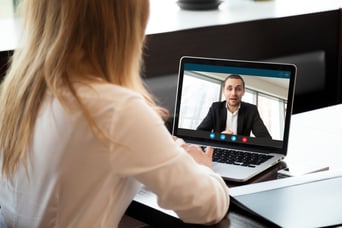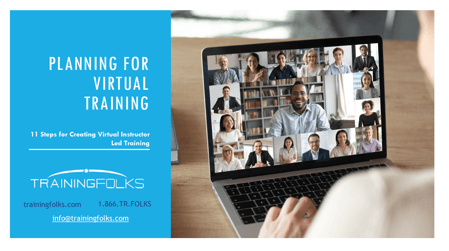Why Every Virtual Training Session Needs a Virtual Training Producer

The way we work and learn has drastically changed over the last 12 months. Instead of on-site education sessions, meetings, or conferences - organizations have moved to Virtual Instructor Led Training (vILT) to continue their learning initiatives. Companies and individuals save both time and money taking part in these virtual training sessions and allow them to continue learning in the ‘new normal’.
Of course, that's only if they were done properly. When poorly produced and maintained, these Virtual training sessions are not useful. In fact, they can be the subject of ridicule and anger from those who invested in them. The result is low engagement, and a program that fails, despite having the best of intentions.
So how do you fix it?
Enter The Producer!
Virtual Instructor Led Training that delivers the best results is reviewed and administered by a Virtual Training Producer. These professionals are responsible for the overall technical success of the event. They work behind the scenes before, during, and after the training as a pillar of support.
There are several reasons why you need this individual for your online training sessions. Here are some of the items on their Virtual training checklist.
1. Preparation
Live training sessions don't fall into place by themselves. It takes rigorous planning and preparation to ensure everything runs smoothly. The Virtual Producer is a vital role and takes responsibility for the whole session.
They obtain an outline of the education session from the trainer that includes moments when they'll be on-screen and when graphics or videos should be incorporated. Next, they check on the platform where the Virtual Instructor Led Training will be held. In some cases, should the program involve multiple presenters, they review virtual conference rooms or, if in the same space, block cameras.
However, the most critical task a VP has is preparing for the unexpected. After they review everything, they run through their virtual training checklist and perform a risk assessment. They detail what can go wrong and how it can be quickly rectified. While some might consider this speculation, it adheres to the Boy Scout motto of always being prepared!
2. Test Audience
As part of their tasks, the Virtual Producer will run through the entire presentation with the required graphics and videos to ensure there is no hiccups in delivery. This is often done by presenting the material to a test audience.
Either within the training or at the end, the VP provides the trainer with critiques that are a mix of positive reviews and suggestions. Sometimes, these are to help with the presentation's technical aspects. Other times, it is to help the trainer themselves improve their performance.
They might ask the facilitator to run through the presentation again by speaking slower or faster. Perhaps the Virtual Producer needs to remind the presenter to look at the camera instead of their notes. The Instructor might need to go through a presentation several times to get the Producer's approval. This is a critical step, ensuring the training runs like a well-oiled machine.
3. Administration
When the day of the live training arrives, the Virtual Producer wears many hats. They tend to be the voice attendees hear when they first join the conference. They also walk them through the controls they can use throughout the session. This is a great way to familiarize learners with the training platform and how to interact with the presenter and other learners.
If attendees can't access the training, the Virtual Producer is available to troubleshoot problems and come up with possible solutions. This means that if one person is having technical issues, the presenter can continue as not to impact the other learners in the group - there is nothing more frustrating for learners when the instructor stops to help one person with a technical issue. They also work with the trainer if they're having issues with their training materials, or technical issues. Say the Instructor loses their internet connection, the Virtual Producer can take the reins, and deliver the training if required.
During the live program, the VP is the person who helps the facilitator with chat moderation and interaction. They are also the person who block participants who are disruptive or argumentative. In other words, the producer is both the host and the bouncer for Virtual Instructor Led Training!
4. Post-Production
Normally, once a live Virtual Training session is completed, it's released as a recording and sent to the participants. This is done for two reasons. It's for participants who want to see it again and for those who couldn't make it to the live presentation.
The training could easily be delivered as-is. However, that comes with the personal and technical problems that may have occurred in the live session. Those who were unable to make the live session shouldn’t also have to sit through any technical issues.
This is where working with a Virtual Producer comes in. They review the video and audio and consider what edits are required. Their responsibility is to smooth things out. By doing so, they provide a professionally designed presentation.
Once completed, the producer uploads the video and/or audio to the respective hosting site. This can be the presenter's website or a location like YouTube. Then, they ensure the presentation runs properly on those platforms. Only when they're satisfied with the results do they inform the Instructor the links can be released to the public.
5. Other Tasks
The items listed above are the prime categories on a Virtual Producers virtual training checklist. However, there are other tasks that may be required before or after the presentation. They are items that help streamline the whole process.
For instance, they could oversee setting up a landing page that not only signs people up for the training but adds them to the facilitator's mailing list. They might also need to create email templates to send reminders to participants about the time and the location for the Virtual Training session.
When the live session is done, the VP might have to review the chat session and deliver any unanswered questions to the Instructor. Once the recorded version is ready, they could be charged with sending out emails with the recorded sessions link to those who signed up.
Needless to say, Virtual Producers aren't simply there to help an Instructor during a live session. Their work begins the moment the idea for the training is created. From there, they team-up with the facilitator on practically every step of the live presentation. To the point that attendees may know more about them than the Instructor.
A Virtual Producer is important for the long-running success of any program. What they do before and after a live training session remains critical to its overall success!
Need help finding the right Virtual Producer for your next training session?
Contact the experts at TrainingFolks!
Get our FREE eBook download
'11 Steps for Creating Virtual Instructor Led Training'
for a step by step guide.


